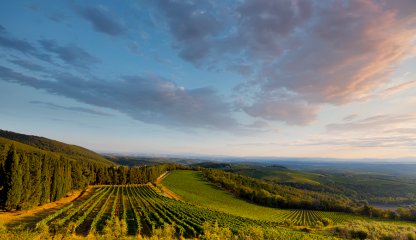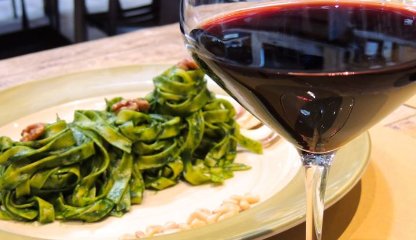Chianti Classico DOCG



Tuscany’s longest-running wine production
The Chianti Classico DOCG label is reserved for wines from the production area with the oldest roots in the vast Chianti territory (the entire administrative area comprising the municipalities of Greve in Chianti, Radda in Chianti, Castellina in Chianti and Gaiole in Chianti and part of the administrative area of San Casciano in Val di Pesa, Tavarnelle Val di Pesa e Barberino Val d’Elsa, Poggibonsi and Castelnuovo Berardenga).
Visiting the Chianti Classico production area means discovering magnificent landscapes and views, but villages and spaces of extraordinary beauty as well: think Radda, the Brolio castle, and San Felice.
Varietals
New regulations allow Chianti Classico wines to use Sangiovese from a minimum of 80 up to 100 percent (in this case, we mean pure Sangiovese). Excluding white grapes, 20 percent of the grape composition can consist in other red wine varietals: Canaiolo, Colorino and other varietals including Cabernet and Merlot are widespread in the area. Remember that a new varietal of Chianti Classico can only enter production phase after four years of processing and the maximum yield (lowered with the new regulations) is set at 75 quintals (7500 kg) per hectare. Chianti Classico wine can be distributed for consumption beginning October 1 of the year following the harvest. The Riserva must undergo an aging process of at least 24 months, 3 of which must be a period of in-bottle refining.
New regulations allow Chianti Classico wines to use Sangiovese from a minimum of 80 up to 100 percent (in this case, we mean pure Sangiovese). Excluding white grapes, 20 percent of the grape composition can consist in other red wine varietals: Canaiolo, Colorino and other varietals including Cabernet and Merlot are widespread in the area. Remember that a new varietal of Chianti Classico can only enter production phase after four years of processing and the maximum yield (lowered with the new regulations) is set at 75 quintals (7500 kg) per hectare. Chianti Classico wine can be distributed for consumption beginning October 1 of the year following the harvest. The Riserva must undergo an aging process of at least 24 months, 3 of which must be a period of in-bottle refining.
Sensory characteristics
Regulations make clear that the scent of Viola odorata should be one of the key characteristics of Chianti Classico. The color must be a vibrant ruby, tending to become more robust as it ages. The taste is balanced, dry but slightly tannic. Minimum alcoholic gradation is 12°, which increases to 12.5° for the Riserva.
Regulations make clear that the scent of Viola odorata should be one of the key characteristics of Chianti Classico. The color must be a vibrant ruby, tending to become more robust as it ages. The taste is balanced, dry but slightly tannic. Minimum alcoholic gradation is 12°, which increases to 12.5° for the Riserva.
Gastronomy
Chianti Classico is a “benchmark” kind of wine that thus pairs well with “benchmark” dishes of the Tuscan tradition, beginning with Florentine-style steak (or rib-eye cuts). But wild boar stew or oven-baked pigeon can also work well. In general, all red meats pair well with Chianti Classico. It can also be enjoyed at the end of a meal paired with a semi-aged or aged Tuscan pecorino. Some diners enjoy Chianti Classico as a complement to cacciucco alla livornese, a traditional fish stew from Livorno, or a similar but lighter take on cacciucco from Viareggio (prepared “alla viareggina”).
Info: chianticlassico.com
Chianti Classico is a “benchmark” kind of wine that thus pairs well with “benchmark” dishes of the Tuscan tradition, beginning with Florentine-style steak (or rib-eye cuts). But wild boar stew or oven-baked pigeon can also work well. In general, all red meats pair well with Chianti Classico. It can also be enjoyed at the end of a meal paired with a semi-aged or aged Tuscan pecorino. Some diners enjoy Chianti Classico as a complement to cacciucco alla livornese, a traditional fish stew from Livorno, or a similar but lighter take on cacciucco from Viareggio (prepared “alla viareggina”).
Info: chianticlassico.com



